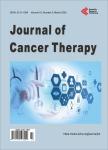Increased Risk of Acute Myeloid Leukemia in Patients with CYP1A1 Polymorphisms
CYP1A1基因多态性的患者在急性髓细胞白血病的风险增加作者机构:Section of Hematology and Blood TransfusionDepartment of Clinical and Experimental OncologyFederal University of Sao Paulo(UNIFESP-EPM)Sao PauloBrazil PharmacovigilancePharmaceutical Product DevelopmentInc.Sao PauloBrazil Disciplina de Ginecologia UNIFESP-EPMFederal University of Sao Paulo(UNIFESP-EPM)Sao PauloBrazil
出 版 物:《Journal of Cancer Therapy》 (癌症治疗(英文))
年 卷 期:2013年第4卷第5期
页 面:971-977页
学科分类:1002[医学-临床医学] 100214[医学-肿瘤学] 10[医学]
基 金:supported by the grant providedby CNPq(Conselho Nacional de Desenvolvimento Científico e Tecnológico).The fellowship grant supported by CNPq was Luís Arthur Flores Pelloso process number 140232/2001-0 period 03/01/2001 to 02/28/2005
主 题:Acute Myeloid Leukemia Karyotype GSTM1 GSTT1 CYP1A1 Gene Polymorphisms Genetic PolymorPhisms Biomarker
摘 要:Acute Myeloid Leukemia (AML) is a group of genetically diverse hematopoietic malignancies arising from cell progenitors developing in the myeloid pathway or from primitive stem cells. Genetic susceptibility of AML may account for an increased risk of AML due to partial metabolism of or biocativation of carcinogens. Chemical compounds are metabolized by a two-tiered phase detoxifying system. Polymorphisms in these pathways may lead to DNA damage and development of AML. We determined the frequencies of carcinogen metabolism gene polymorphisms (CYP1A1, del{GSTM1} and del{GSTT1}) in a case control-study based on polymorphism analysis. Fifty-eight consecutively AML patients (median age 62 years) and 174 sex and age-matched control group were assessed by a PCR-RFLP assay. There were 51 de novo and 7 secondary AML. CYP1A1*2A and CYP1A1*2C polymorphisms were more frequent in CG than AML p 0.001 and in contrast, CYP1A1*3 and CYP1A1*4 were more frequent in AML than CG p 0.001. There were no differences in del{GSTM1} neither del{GSTT1} between AML and CG (p = 0.999 and p = 0.539). Odds ratio for AML in patients harboring CYP1A1*3 was 2.36 (95% CI 1.2 - 4.5), 2.38 for CYP1A1*4 (95% CI 0.8 - 6.8). Adjusted OR was 2.63 for CYP1A1*3 (95% CI 1.4 - 5.1) and 2.66 for CYP1A1*4 (95% CI 0.9 - 7.8). In the multivariate analysis CYP1A1*3 polymorphism was a risk factor for AML with an OR for 3.99 (95%CI 1.9 - 8.6). To the best of our knowledge this is the first study to show that CYP1A1*3 heterozygous genotypes increase the risk of AML. Our data support that inherited absence of this carcinogen detoxification pathway may be an important determinant of AML.



